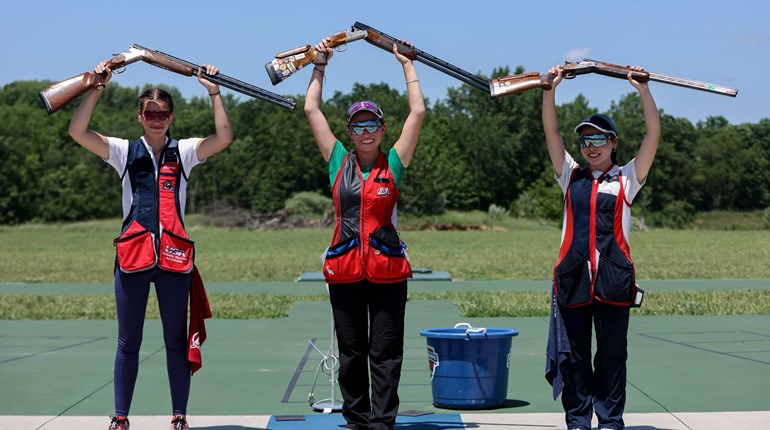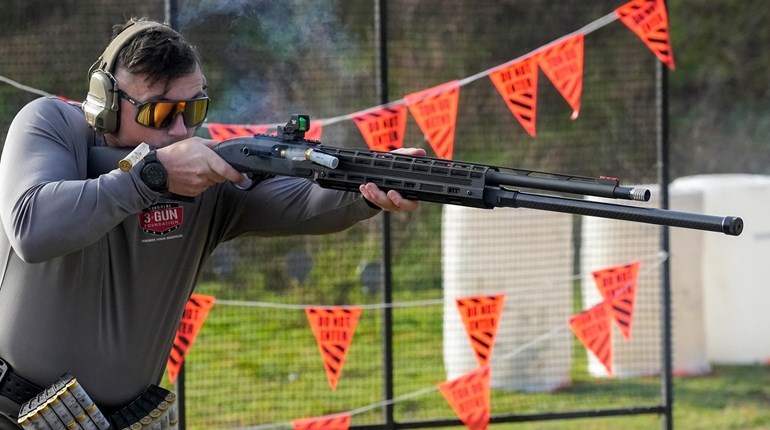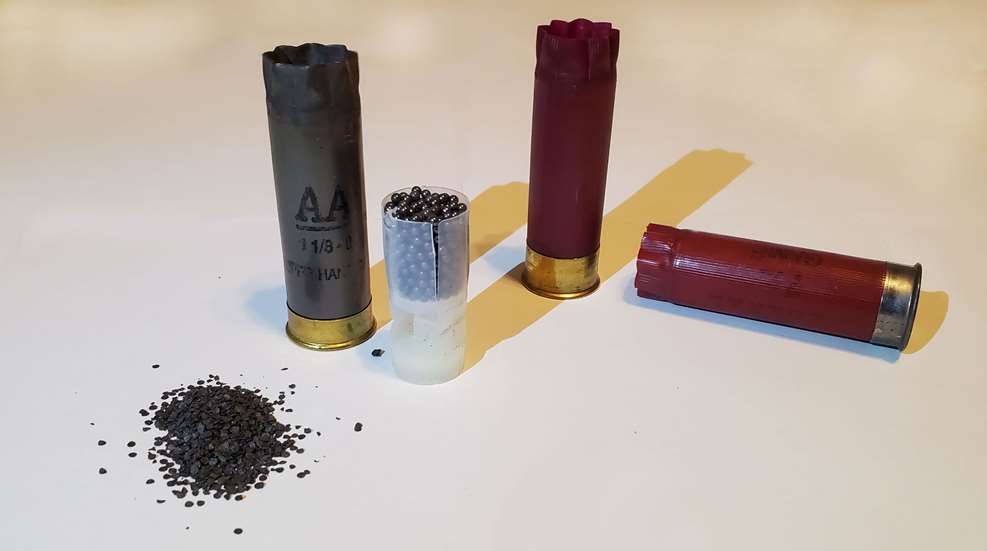
Shotguns are different from most other firearms, because in most cases (slugs being the exception) they are firing multiple projectiles rather than a single bullet, as a rifle or handgun would fire. This is ideal for moving targets such as birds and clay targets, as it creates a “spread” of pellets that makes it more likely that some of the pellets will strike the target.
We load shotguns with shotgun shells, which look like a hard plastic tube with a metal cap on one end. But what exactly is inside? There are six main components of a shotgun shell: the primer, the base, the powder, the wad, the projectiles (shot) and the hull.
The Hull 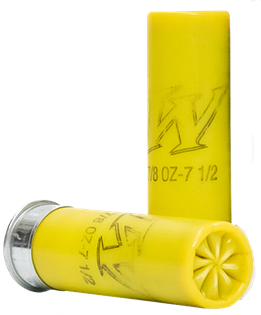
The hull is the plastic case that holds everything together. Paper models, though much less popular, are also available. Hulls come in many colors, and different companies might use different colors to differentiate their brand from others. There is only one real universal truth: all 20-gauge hulls are yellow as a safety precaution, to prevent shooters from mixing up 12- and 20-gauge ammo. Yellow is not used for any other gauge.
Manufacturers use slightly different hulls depending on the intended purpose of the shell—hunting vs target shooting. Good hulls can be reused by anyone who reloads and are crimped at the top to seal the components securely inside.
The Base 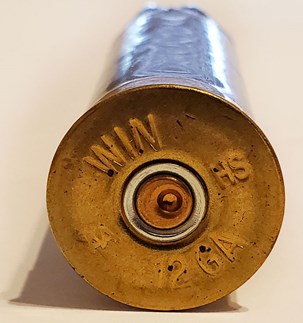
The base, generally made of brass but sometimes made of steel, is at the bottom of the hull. It holds the primer and has a rim around its bottom edge that is engaged by the gun’s action to hold the shell in place and eject it after the shot. Some bases are higher than others, which is where we get the term “high-brass shells.” Generally, more powerful loads will use higher brass, although with modern hulls, the difference is more cosmetic than functional.
Bases remain attached to the hull permanently and can be reused by reloaders. (This shell has been fired—you can see the small indent in the primer, caused by the firing pin striking it.)
The Primer
Inside the center of the base is a small opening called the primer pocket. It holds a primer, which is a little metal tube that contains a tiny amount of explosive. It is this explosive that ignites the shell’s powder charge and starts the shot. See the end of this article for more explanation of how this sequence works. Shotgun primers are different from the primers used in rifle and pistol ammunition, and a primer is only used once. Reloaders who are reusing hulls will insert a fresh primer into the base of the shell each time they reload it.
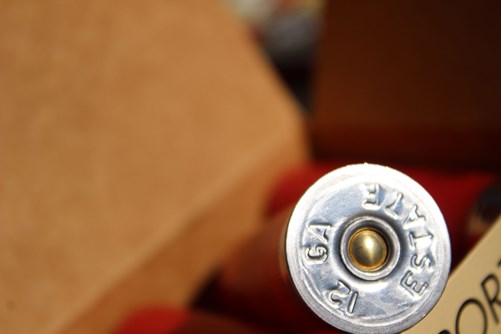
The Powder Charge
A small amount of smokeless gunpowder sits atop the primer in the base of a shotgun shell. When ignited by the primer, this powder burns quickly and propels the wad and shot down the barrel. Like primers, powder is specific to different applications.
More or less powder is loaded into shells depending on what the shell is to be used for. All else being equal, more powder will mean the shot travels faster, which means the recoil in the opposite direction (your shoulder) will be harder.
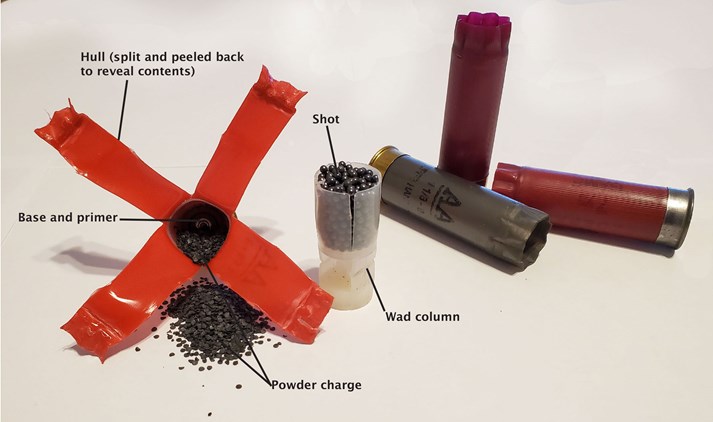
This photo shows several already-fired hulls with the bases attached, and a live shell split open with the contents spilled out of the hull: powder charge, wad column, shot.
The Wad Column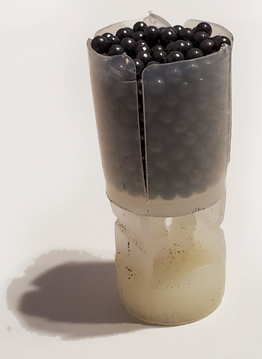
Sometimes this comes in two separate parts (a shot cup and a wad), but most commonly, the two are combined into one thing called the wad column. The wad column is a barrier between the powder and the pellets—the top of it is essentially a little cup that holds all the shot pellets. Wad columns keep pellets from bouncing all over the place as they travel down the barrel, preserving the shot’s pattern.
In the past, wads were made of paper, fiber or cardboard. Today, they’re almost all plastic, with some companies offering biodegradable options.
The Shot
This could be a series of articles by itself, but the shot pellets (referred to as just “shot”) are the projectiles that strike the target. They are most commonly made of lead, steel, bismuth or other metals. Lead is for target loads and some upland bird hunting loads. Steel, bismuth and other non-toxic metals are for waterfowl nationwide and upland hunting in areas where it is required.
Shot comes in a wide array of sizes, from the tiny #9 to the massive 000 Buck, with different sizes being more appropriate for different uses.
How a Shot Comes Together
When you load a shell into a shotgun and pull the trigger, the gun’s firing pin smacks the primer. This causes the explosive inside the primer to…well, explode, which catches the powder on fire. The powder burns rapidly, and all that energy generated by the burning bursts open the crimp at the end of the hull and launches the wad and the shot pellets out of the barrel.
The wad exits the barrel with the shot pellets, then falls to the wayside yards downrange while the pellets continue toward the target. Many wads are made with “petals” that pop open when they meet air resistance outside the barrel, causing them to quickly lose velocity and fall to the ground, out of the way of the shot.
Then, if all goes well, the only thing left is for the pellets to strike the target!













